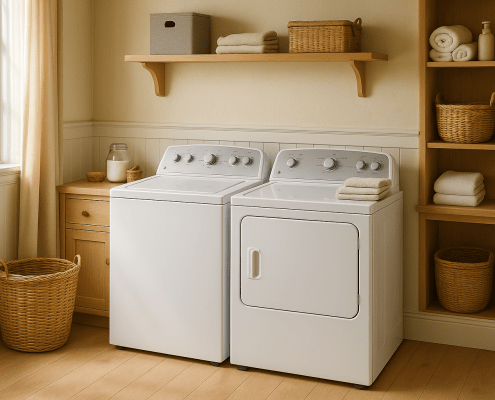Washing Machine Making Burning Smell: Top 5 Problems and Fixes for Top-Loading and Side-Loading Washers (With Video!)
APP Expert / Monday October 11, 2021
Is your washing machine emitting an unsettling burning smell? Don’t worry—you’re not alone, and we’ve got the perfect solution for you! Dive into our step-by-step guide, complete with a handy how-to video, to identify and resolve this common household issue so you can keep your appliances running smoothly.
When a burning smell is emitting from the washing machine, there are a five main washer parts that might be broken or damaged. Before troubleshooting any of these parts, make sure to unplug the washing machine or turn off the circuit breaker that it is on. The hot and cold water supply to the washing machine should also be turned off. This will ensure your safety while working with the parts of the machine. Once your machine is safe to work with, continue with this guide to diagnose your washing machine yourself.
Once you have identified the part needed for your washer, search below using your specific washing machine model number to identify the exact part needed:
1. Drive Belt
When a burning smell is emitting from the washing machine, there are a few components that might be broken or damaged. Before troubleshooting any of these parts, make sure to unplug the washing machine or turn off the circuit breaker that it is on. The hot and cold water supply to the washing machine should also be turned off. This will ensure your safety while working with the parts of the machine.
The drive belt is one of the first parts to check when a washing machine has a burning smell. It connects the drive pulley to the motor pulley so the inner tub is able to spin and agitate to clean clothes. There are two types of belts: groove belts and V-style belts. Regardless of the style in the washer, a burning smell could mean the belt is stretched out, old, and slipping on the pulleys.
With a front-loading washer, the drive belt is typically on the back. Top-loading washing machines often have drive belts on the bottom. A visual inspection of the belt can give you insight into whether it is damaged. If it is, it will need to be replaced. These belts can wear out over time, so a proper inspection on a regular basis is recommended.
2. Start Capacitor
If there isn’t an issue with the drive belt, the next thing to consider is whether there are problems with the start capacitor. This part offers a boost of extra electricity to assist the washing machine motor with starting. This device stores electricity and then releases it when the motor in the washing machine needs to start. This provides additional power and torque to begin the washing cycle.
Different washing machines have start capacitors in various locations. It might be mounted on the back wall or it could be located near the motor. When aging, a motor capacitor can fail due to drying out. An internal short-circuit can also occur when the component is going bad and could cause melting, which can lead to a burning smell when the washer is starting.
A visual inspection of the capacitor can show whether it has melted or has a bulge. If this is the case, the part has gone bad, and the start capacitor needs to be replaced. It is not safe to use a washing machine with melting or burning parts so the replacement should be prioritized.
3. Drive Motor
Another source of a burning smell in a washing machine can be the drive motor. It’s responsible for converting electrical energy into mechanical energy to drive the washing machine. The drive motors on washing machines come in different styles and sizes, but each of them is responsible for the same thing. Some use a belt and pulley system while others have a direct drive motor that drives the tub.
With a top-loading washer, the motor is typically mounted near the bottom of the machine. Front loading washing machines with direct drive motors will usually have them installed on the back of the tub, while those with a belt will be mounted at the bottom of the tub. If the terminal block or the motor windings fail, arcing inside the motor can occur, which will lead to a burning smell.
If the odor is coming from the motor, first, check that nothing is binding it up. With a top-loading washer, the belt or motor may need to be removed to turn the transmission. This is done to ensure the belt and motor aren’t locked up. While the motor is free to check for jams, if you have a drain pump connected to the motor, now is the time to make sure it isn’t blocked.
On a front-loading washer with a belt, take the belt off to determine whether the motor and tub spin. For direct drive front loading washing machines, turning the rotor will determine whether it spins freely. If there is no jam but a burning smell is still present, the motor has likely failed and will need to be replaced.
4. Idler Pulley
The idler pulley is the next component that can cause a burning smell from a washing machine. This part places tension on the belt to drive the tub when the machine is running. The idler pulley will be found mounted on the idler arm on a shaft. It rides on a bearing, and if the bearing has gone bad, the excess friction can cause the plastic idler to melt and emit a burning smell that may be noticeable.
Some of the other symptoms of a bad idler pulley include a squealing belt, visibly worn areas on the pulley, and damaged pulleys or bearings. Squealing belts are common when a belt is rubbing against the pulley and can cause binding and slipping. The second symptom can be determined by scoring marks on the pulley surface where it has had contact with the belt. If the pulley or bearing is broken, it’s often easy to see during a visual inspection. The belt might be torn or falling off of the engine.
Washing machines that use idler pulleys will have the part located between the transmission pulley and the motor pulley. Removing the drive belt can give you access to the idler pulley so it can be visually inspected. Once the belt is off, check whether the pulley spins freely. Any deformities or discoloration should also be noted at this time. This indicates the part is melted and will need to be replaced as soon as possible.
5. Control Boards
The control boards are the components that control all of the washing machine functions and can sometimes cause a burning smell. There is a wide selection of control boards, depending on the manufacturer of the washing machine. The most common include the main control board, the motor control board, and the user interface board.
Each of the boards has different components which can fail and create a burning smell from the washing machine. The boards can be located in various locations inside of the washer. The user interface boards and main control boards are often found in the control panel itself, while the motor control board is typically located at the bottom of the washing machine.
If an odor is coming from the location of a control board, it should be visually inspected for burn marks that indicate the boards have gone bad. If any damage is present on any of the boards, it will need to be replaced. A washing machine that has a burning smell typically has one of the problems listed above, and the component being replaced should alleviate the issue.
Where To Find Us
If you need any replacement parts for your appliances, you can enter your model number at AppliancePartsPros.com to locate and order them quickly. Most orders arrive in just two business days, and we have tons of great information in our repair help section and YouTube videos to help you troubleshoot.
Stay connected with the latest DIY tips, tutorial videos, and repair guides by following us on Facebook, Instagram, and Twitter. We love hearing about your repair stories and successes. If you need more help or want personalized guidance, feel free to contact or call us at 877-477-7278. We’re ready to help you take on your next project with confidence!
Since 1999, AppliancePartsPros.com has helped millions of people repair their broken appliances by providing high-quality original parts at well below retail prices, free support and troubleshooting, and award-winning customer service from an expert, friendly, US-based customer support team!
Hi! I’m Matt H., and I’m thrilled to be your guide through the world of appliance repair with over 25 years of invaluable experience in the industry.
From the early days of my career, I have been deeply passionate about appliances and their inner workings. Over the years, I’ve seen it all – from vintage models to the latest cutting-edge technology – and I’ve dedicated myself to mastering the art of repair. With a toolbox in one hand and a wealth of knowledge in the other, I’ve tackled every challenge that has come my way, learning and growing with each repair.
Join me as we dive into the intricacies of appliance repair. From step-by-step repair guides to explanations of common problems and their solutions, I’ll be here to simplify the repair process and empower you with the knowledge you need to keep your appliances running smoothly.
Feel free to explore our blog, ask questions, and leave comments – this platform is a space for learning, sharing, and growing together. Let’s work together to ensure that your appliances continue to serve you for years to come.
Thank you for joining me on this journey, and I look forward to being your go-to resource for all things related to appliance repair!





